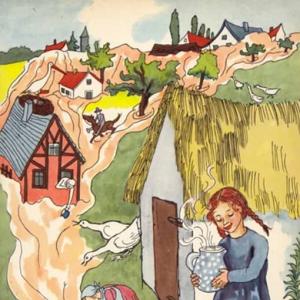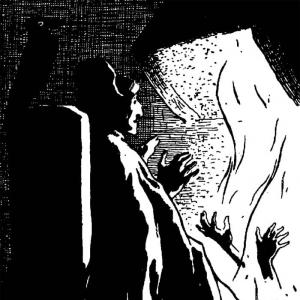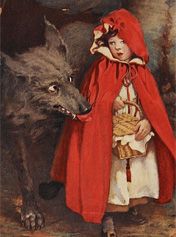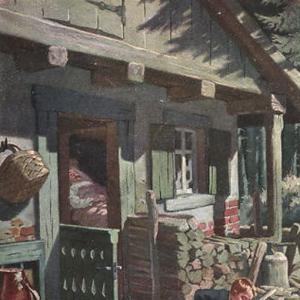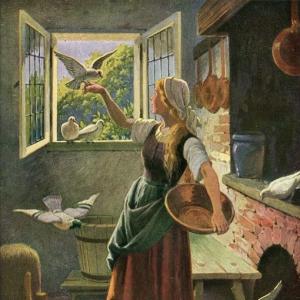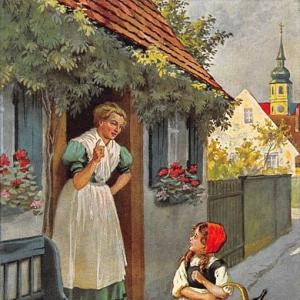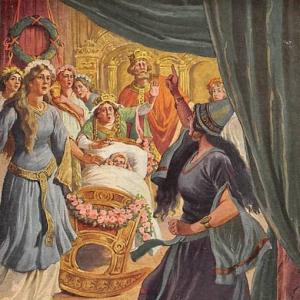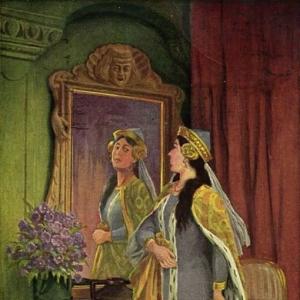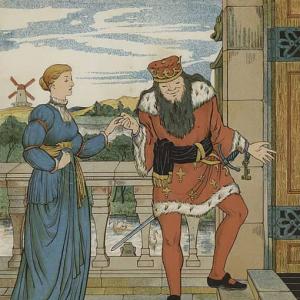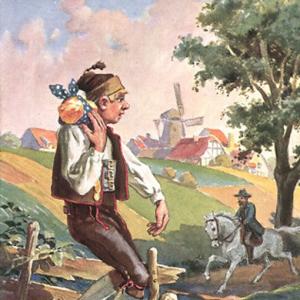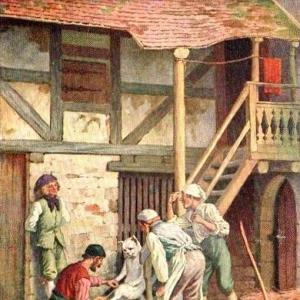Reading time: 6 min
The wolf had the fox with him, and whatsoever the wolf wished, that the fox was compelled to do, for he was the weaker, and he would gladly have been rid of his master. It chanced that once as they were going through the forest, the wolf said, „Red-fox, get me something to eat, or else I will eat thee thyself.“ Then the fox answered, „I know a farm-yard where there are two young lambs. If thou art inclined, we will fetch one of them.“ That suited the wolf, and they went thither, and the fox stole the little lamb, took it to the wolf, and went away. The wolf devoured it, but was not satisfied with one. He wanted the other as well, and went to get it. As, however, he did it so awkwardly, the mother of the little lamb heard him, and began to cry out terribly, and to bleat so that the farmer came running there. They found the wolf, and beat him so mercilessly, that he went to the fox limping and howling. „Thou hast misled me finely,“ said he; „I wanted to fetch the other lamb, and the country folks surprised me, and have beaten me to a jelly.“ The fox replied, „Why art thou such a glutton?“
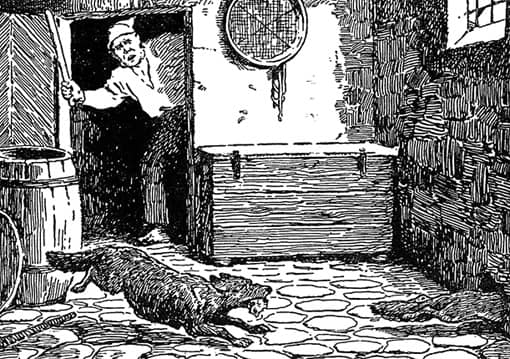
Next day they again went into the country, and the greedy wolf once more said, „Red-fox, get me something to eat, or I will eat thee thyself.“ Then answered the fox, „I know a farm-house where the wife is baking pancakes to-night. We will get some of them for ourselves.“ They went there, and the fox slipped round the house, and peeped and sniffed about until he discovered where the dish was, and then drew down six pancakes and carried them to the wolf. „There is something for thee to eat,“ said he to him, and then went his way. The wolf swallowed down the pancakes in an instant, and said, „They make one want more,“ and went thither and tore the whole dish down so that it broke in pieces. This made such a great noise that the woman came out, and when she saw the wolf she called the people, who hurried there, and beat him as long as their sticks would hold together, till with two lame legs, and howling loudly, he got back to the fox in the forest. „How abominably thou hast misled me!“ cried he, „the peasants caught me, and tanned my skin for me.“ But the fox replied, „Why art thou such a glutton?“
On the third day, when they were out together, and the wolf could only limp along painfully, he again said, „Red-fox, get me something to eat, or I will eat thee thyself.“ The fox answered, „I know a man who has been killing, and the salted meat is lying in a barrel in the cellar. We will get that.“ Said the wolf, „I will go when thou dost, that thou mayest help me if I am not able to get away.“ – „I am willing,“ said the fox, and showed him the by-paths and ways by which at length they reached the cellar. There was meat in abundance, and the wolf attacked it instantly and thought, „There is plenty of time before I need leave off!“ The fox liked it also, but looked about everywhere, and often ran to the hole by which they had come in, and tried if his body was still thin enough to slip through it. The wolf said, „Dear fox, tell me why thou art running here and there so much, and jumping in and out?“
„I must see that no one is coming,“ replied the crafty fellow. „Don’t eat too much!“ Then said the wolf, „I shall not leave until the barrel is empty.“ In the meantime the farmer, who had heard the noise of the fox’s jumping, came into the cellar. When the fox saw him he was out of the hole at one bound. The wolf wanted to follow him, but he had made himself so fat with eating that he could no longer get through, but stuck fast. Then came the farmer with a cudgel and struck him dead, but the fox bounded into the forest, glad to be rid of the old glutton.
 Learn languages. Double-tap on a word.Learn languages in context with Childstories.org and Deepl.com.
Learn languages. Double-tap on a word.Learn languages in context with Childstories.org and Deepl.com.Backgrounds
Interpretations
Adaptions
Summary
Linguistics
„The Wolf and the Fox“ is a German fairy tale collected by the Brothers Grimm, Jacob and Wilhelm, in their famous compilation, „Grimm’s Fairy Tales“ (originally published as „Children’s and Household Tales“ in 1812). The Brothers Grimm were German academics, linguists, and cultural researchers who collected and published over 200 folktales in their lifetime. Their work has had a significant impact on the development of folklore studies and Western storytelling.
The story of „The Wolf and the Fox“ is part of the Aarne-Thompson-Uther (ATU) classification system, which is a catalog of folktale types used for organizing and analyzing folklore from around the world. This specific story falls under ATU type 41, „Overeating in the Pantry.“
The tale is an example of the „trickster“ archetype, which is common in folklore across many cultures. The trickster character, in this case, the fox, is known for their cunning, intelligence, and ability to outwit others. In „The Wolf and the Fox,“ the clever fox uses his wits to survive and eventually free himself from the wolf’s control.
The story also illustrates the common folktale theme of the weak outsmarting the strong, as well as the dangers of greed and gluttony. It serves as a moral lesson for readers, reminding them of the importance of adaptability, being mindful of the consequences of one’s actions, and the value of wisdom over brute force.
„The Wolf and the Fox“ offers several interpretations and lessons:
Greed and Gluttony: The wolf’s insatiable appetite leads to his downfall. This cautionary tale warns readers about the dangers of being greedy and overindulging, as it can result in negative consequences.
Cunning vs. Brute Force: The story highlights the contrast between the fox’s cunning and the wolf’s brute force. The fox uses his intelligence to survive and escape danger, whereas the wolf relies on strength, which ultimately fails him. This can be seen as a lesson that wit and strategy can often outsmart raw power.
Loyalty and Manipulation: The fox serves the wolf out of fear and necessity, rather than genuine loyalty. The story demonstrates how people may be forced to cooperate with someone more powerful even when they would prefer not to. The fox, however, manages to use his intelligence to eventually free himself from the wolf’s control.
Consequences of Actions: The wolf repeatedly ignores the fox’s advice and suffers the consequences of his actions. This can be interpreted as a lesson to listen to the wisdom of others and be mindful of the potential outcomes of one’s actions.
The Importance of Adaptability: The fox’s ability to adapt to different situations and think on his feet saves him from harm. This teaches the value of being flexible and resourceful in the face of adversity.
In summary, „The Wolf and the Fox“ provides a moral lesson on the dangers of greed and the importance of cunning, adaptability, and considering the consequences of one’s actions.
„The Wolf and the Fox“ has been adapted and retold in various forms over the years, including in literature, film, and television. Here are a few notable adaptations:
„The Wolf and the Fox“ retold by Anne Sexton: American poet Anne Sexton retold the story in her book „Transformations“ (1971), a collection of fairy tale adaptations. Sexton’s version features a more feminist perspective, with the fox being portrayed as a female character who uses her intelligence and cunning to survive in a male-dominated world.
„The Pig Brother“ by the Brothers Grimm: A similar tale to „The Wolf and the Fox“ is „The Pig Brother,“ also collected by the Brothers Grimm. In this story, the pig is the main character and is aided by a variety of animals, including a wolf and a fox, in his quest to escape being eaten. The story teaches similar lessons about wit, resourcefulness, and trust.
„The Fox and the Wolf“ by Aesop: The Greek storyteller Aesop also has a fable called „The Fox and the Wolf,“ which shares similarities with „The Wolf and the Fox.“ In this story, the fox and the wolf are both hungry and decide to steal a sheep. The fox tricks the wolf into stealing the sheep, but then runs away, leaving the wolf to be caught and punished.
„The Adventures of Pinocchio“ by Carlo Collodi: In this classic Italian novel, Pinocchio encounters a fox and a cat who trick him into giving them his gold coins. The story shares similarities with „The Wolf and the Fox“ in that it warns against trusting strangers and highlights the importance of being careful and discerning.
„The Fox and the Hound“ by Disney: This animated film from 1981 is loosely based on the novel by Daniel P. Mannix and tells the story of a fox and a hunting dog who become friends despite their natural instincts to be enemies. While the story is not a direct adaptation of „The Wolf and the Fox,“ it shares themes of unlikely friendships and the power of overcoming stereotypes.
In „The Wolf and the Fox“ by the Brothers Grimm, the weaker fox is compelled to do as the wolf commands. One day, the hungry wolf demands food, so the fox leads him to a farmyard where they steal a lamb. The wolf devours it but wants more, attempting to steal the second lamb himself. However, he is caught by the farmer and beaten severely.
The next day, the wolf again demands food, so the fox takes him to a house where a woman is baking pancakes. The fox steals six pancakes, but the unsatisfied wolf wants more and ends up making a mess, alerting the woman. The townspeople find the wolf and beat him again.
On the third day, the wolf demands food once more, and the fox takes him to a cellar filled with salted meat. As the wolf indulges himself, the fox remains vigilant, making sure he can still fit through their escape hole. When the farmer discovers them, the fox escapes, but the wolf, now too fat to fit through the hole, is caught and killed by the farmer. The fox, now free of the greedy wolf, bounds happily into the forest.
The fairy tale „The Wolf and the Fox“ by the Brothers Grimm is rich with themes and linguistic elements typical of traditional folklore.
Below is an analysis of some of these aspects:
Characters and Dynamics
Character Archetypes:
The Wolf: Represents brute strength, greed, and gluttony. His repeated demands and inability to satiate his hunger drive the narrative forward. Despite his physical power, he lacks cunning and foresight.
The Fox: Embodies cunning, intelligence, and adaptability. Though weaker physically, he survives through wit, manipulating the wolf to ensure his own safety.
Power Dynamics: There is a clear hierarchical relationship where the fox is subservient to the stronger wolf due to physical power. However, the fox’s intellectual superiority allows him to subvert this dynamic to his advantage.
Repetition: The phrase „get me something to eat, or else I will eat thee thyself“ is repeated throughout the story, emphasizing the wolf’s insatiable hunger and the fox’s precarious position.
Dialogue: Dialogue between the wolf and the fox adds to the storytelling by characterizing their relationship. The wolf’s harsh imperatives contrast with the fox’s careful, cunning responses.
Descriptive Language: Use of vivid verbs (e. g. , „limping,“ „howling,“ „sniffed“) creates a dynamic and engaging narrative, helping readers visualize the actions and consequences of each character’s decisions.
Themes
Cunning vs. Strength: The tale explores the theme of brain versus brawn, highlighting how intelligence can overcome physical strength.
Gluttony and Consequence: The wolf’s greed leads to his downfall, illustrating a moral lesson about the dangers of excess and lack of moderation.
Survival: The fox’s actions are driven by a need to survive, showcasing adaptability and cleverness as essential traits for overcoming adversity.
Moral Lessons
Greed and its Consequences: The narrative warns against unchecked greed. The wolf’s excessive appetite and failure to heed the fox’s warnings result in his demise.
Value of Intelligence: The fox’s ability to outwit the wolf signals the importance of intelligence and strategic thinking over sheer physical power.
Overall, „The Wolf and the Fox“ utilizes common fairy tale elements—such as anthropomorphized animals, repetitive structures, and moral lessons—to deliver a timeless story about the interplay between cunning and strength. The characters‘ interactions and the unfolding consequences of their actions emphasize traditional values while entertaining with their vivid depiction.
Information for scientific analysis
Fairy tale statistics | Value |
|---|---|
| Number | KHM 73 |
| Aarne-Thompson-Uther-Index | ATU Typ 41 |
| Translations | DE, EN, DA, ES, FR, PT, IT, JA, NL, PL, RO, RU, TR, VI, ZH |
| Readability Index by Björnsson | 29.5 |
| Flesch-Reading-Ease Index | 84.5 |
| Flesch–Kincaid Grade-Level | 6.5 |
| Gunning Fog Index | 9.2 |
| Coleman–Liau Index | 7 |
| SMOG Index | 7.6 |
| Automated Readability Index | 6.9 |
| Character Count | 3.701 |
| Letter Count | 2.807 |
| Sentence Count | 36 |
| Word Count | 724 |
| Average Words per Sentence | 20,11 |
| Words with more than 6 letters | 68 |
| Percentage of long words | 9.4% |
| Number of Syllables | 872 |
| Average Syllables per Word | 1,20 |
| Words with three Syllables | 21 |
| Percentage Words with three Syllables | 2.9% |

 Facebook
Facebook  Whatsapp
Whatsapp  Messenger
Messenger  Telegram
Telegram Reddit
Reddit